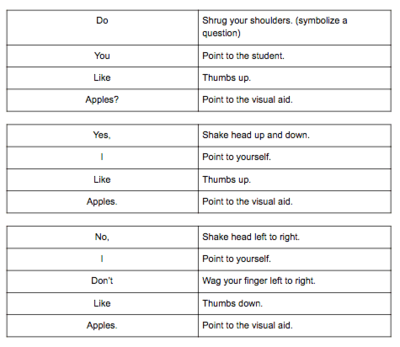Techniques to Transmit New and Difficult Concepts to Students

Every day, we learn something new. It can happen on the street, at work, at school and even in our home. We can attain new skills and knowledge through our interactions with our surroundings. Utilizing our 5 senses and past experiences to make sense of what is going on, we can ascertain new concepts and make proper use of them in our daily lives. However, as a teacher, we are tasked with transmitting abstract concepts that become difficult to fully grasp through traditional methods. Consequently, some teachers rely on literal translations to bring the point across.
Table of Contents
Since the student's exposure to the target language can be extremely limited outside of the classroom, it's important to fully immerse the students in the language while in the classroom. The following post will discuss a few alternatives to help teach difficult or abstract concepts inside a class, without having to rely on translation. This will ensure an enriching learning environment for both students and teachers.
VISUAL AIDS
A common, but effective tool that teachers use are visual aids. They can consist of the following:
- PowerPoint presentations
- Flashcards
- Posters
- Videos
- Tangible objects
- Many more…
As we can see, our resources for visual aids are plentiful. Because there are a plethora of visual aids at our disposal, we can adjust our lesson plans according to the available resources.
ACTING/ROLE PLAY
At times, visual aids cannot fully express a concept and can leave students with more questions than answers. That means it's time to bust out another tool from our utility belt. Here is where "acting" can come and save the day. Acting can be used as a form of immersion for the students and have them become part of the explanation for the concept.
For example; Part of today's lesson is teaching the concept of "help/helping" along with the phrases, "Who can help me?" and "I can help you!". So I, as the teacher, become the first example. I go to the front of the classroom and suddenly pretend to fall onto the floor. I reach out to the students and say, "Who can help me?". Next, I would coach the students to say the proper response, which is, "I can help you!" Then, I would choose one student to help me up, and select two volunteers to proceed with the next example. This activity not only helps with the understanding of the new concept but brings a dynamic element that encourages participation inside the classroom.
Also read: Top Online Lesson Plan Resources for New and Advanced Teachers

ENUNCIATION AND SPEECH
To adequately establish an understanding of any concept, it's important to make sure the students know the correct pronunciation of the vocabulary at hand. This is important because it prevents them from confusing one topic with another. A common example when speaking are the words "this" and "these" or "accept" and "except".
Correct enunciation is used by exaggerating our mouth movements. This allows students to see how to move their lower facial features and correctly pronounce the word. This is not something that can be taught in a single class, but over time with practice, their pronunciation and understanding of the concept will improve tremendously. We must also take into consideration our tone of voice and speed when addressing the students. If we speak too fast in a low tone, much of the information is lost. Be clear and concise when speaking.
Also read: Top Time Fillers for an EFL Classroom
MIMING
Miming involves utilizing corporal movements to get something across. It seems similar to role-play, but not quite. This technique can be used in many different ways. Here, a technique similar to sign language and charades will be explained. This is useful with true beginners or young children. This will allow the students to understand the individual words being said, as well as, the complete idea that's trying to be expressed.
The example we are going to use is going to be about apples. The sentence structures that need to be learned in today's class are: "Do you like apples?", "Yes, I like apples.", "No, I don't like apples.".

This technique will allow students to indirectly learn additional vocabulary. These actions must be shown to the whole class, before taking the "miming" to a role-play activity with the students.

CONCLUSION
Learning a new language can sometimes seem like an impossible task for many people. However, it doesn't mean it has to be. As teachers, our responsibility is to provide a healthy and enriching learning environment. This implies that the teacher is providing an immersive experience the moment the student steps into the classroom. Our creativity can bring any lessons to the next level and draw out the hidden potential of our students.
The tips described in this blog post can be a great asset to any teaching plan. I encourage teachers to continue seeking out new innovative teaching techniques, and create their own unique teaching style.
Apply now & get certified to teach english abroad!
Speak with an ITTT advisor today to put together your personal plan for teaching English abroad!
Send us an email or call us toll-free at 1-800-490-0531 to speak with an ITTT advisor today.
Related Articles:
- The How-To Guide to Prepare for Your Teaching Job Abroad
- Two Traveling Teachers Share What It's Like Teaching English Abroad as a Couple
- Guide to Writing a TEFL Resume That Will Get You Hired
- Top 10 Places to Take Your TEFL Course in Spring
- 8 Important Tips For Good Classroom Management
- 6 Steps To Becoming a More Confident Teacher



